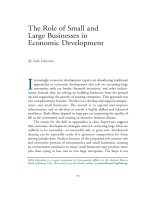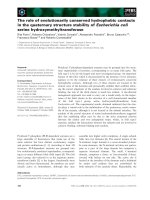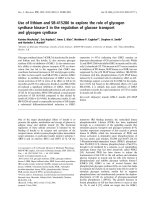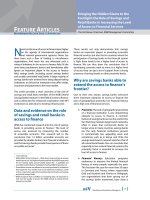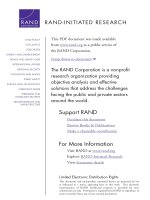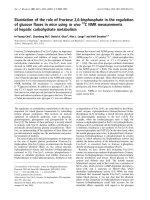The Role of Genetically Modified Organisms (GMOs) in Beverage Production
Bạn đang xem bản rút gọn của tài liệu. Xem và tải ngay bản đầy đủ của tài liệu tại đây (3.76 MB, 6 trang )
2
The Role of Genetically
Modified Organisms
(GMOs) in Beverage
Production
Susan Harlander
CONTENTS
History of Genetic ModiÞcation of Food Plants and Animals
Regulation of Genetically ModiÞed Crops
Identity Preservation and the International Market
Detection of Genetically ModiÞed Ingredients
DifÞculties with Product Labeling
The Future of Genetically ModiÞed Foods
In the relatively short time since their commercial introduction in 1996,
genetically modiÞed (GM) crops have been rapidly adopted in the U.S. The
Þrst products of plant biotechnology involve input traits, such as herbicide
tolerance and insect resistance. Of the 51 products reviewed by the U.S.
Food and Drug Administration (FDA), the vast majority are commodity
crops such as corn, soybeans, and canola. Because FDA considers these
crops “substantially equivalent” to their traditional counterparts, no special
labeling is required for GM crops in the U.S., and they are managed as
commodities with no segregation or identity preservation (IP). This creates
an issue for multinational beverage manufacturers since labeling guidelines
for and consumer acceptance of GM crops differ in other parts of the world.
This chapter will focus on the challenges associated with establishing IP
systems for commodity ingredients through a food supply chain geared for
maximum efÞciency and least cost. It will also address current testing
systems for GM ingredients, including both protein- and DNA-based meth-
ods. The growing need for accurate, speciÞc, reliable, standardized, and
TX110_book Page 9 Tuesday, May 6, 2003 9:21 AM
© 2003 by CRC Press LLC
validated testing methods to ensure compliance with established threshold
levels for GM ingredients as well as global labeling guidelines will be
discussed. Finally, examples of next-generation biotechnology products of
relevance to the beverage industry will be provided.
HISTORY OF GENETIC MODIFICATION
OF FOOD PLANTS AND ANIMALS
People have been genetically modifying the food supply during the thousands
of years since the domestication of plants and animals began. Classical
breeding and selection, as well as techniques such as radiation breeding,
embryo rescue, and transposon mutagenesis, create signiÞcant changes in
the genetic makeup of plants and animals due to the random recombination
and sorting of thousands of genes. As a result of intervention by people, the
hybrid seed corn currently grown throughout the world bears little resem-
blance to teosinte, the original ancestor of corn. The newer techniques involv-
ing genetic engineering, on the other hand, allow for the transfer of a few
genes in a much more precise, controllable, and predictable manner than
that occurring as a result of conventional breeding. Interestingly, plants
improved through conventional genetic modiÞcation methods undergo no
formal food or environmental safety evaluation prior to introduction into the
marketplace, whereas genetically engineered crops are required to undergo
extensive food and environmental safety testing before their introduction.
Genetically modiÞed crops were Þrst commercially introduced in the
U.S. in 1996 and have been rapidly adopted by farmers. It has been estimated
that 24% of the corn and almost 70% of the soybeans and cotton grown in
the U.S. in 2001 were GM varieties. Examples of GM crops include insect-
resistant (Bt) corn, cotton, potato, and tomato; herbicide-tolerant soybeans,
corn, rice, sugar beet, ßax, and canola; and virus-resistant squash, papaya,
and potato. Advantages of insect- and virus-resistant crops include improved
yields and reduced use of pesticides. An additional beneÞt of Bt corn is
reduced contamination by fumonisin-producing fungi. Fumonisin is a potent
mycotoxin implicated in esophageal cancer and neural tube birth defects in
humans. Advantages of herbicide-tolerant crops include improved weed con-
trol, reduced crop injury, reduction in foreign matter, reduced fuel use, and
signiÞcant reduction in soil erosion. It is for these reasons that GM crops
are the most rapidly adopted technology in the history of agriculture.
REGULATION OF GENETICALLY MODIFIED CROPS
GM crops are regulated in the United States through a coordinated frame-
work developed in 1992 and administered by three agencies: the U.S.
TX110_book Page 10 Tuesday, May 6, 2003 9:21 AM
© 2003 by CRC Press LLC
Department of Agriculture (USDA), the Environmental Protection Agency
(EPA), and the FDA. Rigorous food and environmental safety assessments
must be completed before GM crops can be commercialized. An effective
food safety evaluation system minimizes risk, but it is important to remem-
ber that food is not inherently safe. There are numerous examples of natural
toxicants present in various foods (e.g., solanine in potatoes and glycoal-
kaloids in broccoli). If we were to eliminate all foods that posed any kind
of risk, our food choices would be very limited. The goal of a food safety
system is “reasonable certainty of no harm” at normal levels of consump-
tion. Acceptance of a new food product occurs when it is shown to be as
safe as or safer than its conventional counterpart; therefore, the Þnal assess-
ment of safety is always comparative.
The scientiÞc basis of the evaluation process is the concept of “substantial
equivalence.” Regulatory agencies compare GM crops to their conventional
counterparts. A wide range of comparisons is made including nutritional
equivalency, levels of natural toxicants, and the potential for allergenicity,
in addition to a number of agronomic and environmental factors. If the GM
crop is essentially identical to its conventional counterpart in all aspects, it
is considered substantially equivalent, and no special labeling is required in
the U.S. Over 400 million acres of GM crops have been grown worldwide,
and there has not been a single documented adverse health effect or food
safety issue associated with consumption of these products.
Since GM crops are substantially equivalent and no labeling is required,
they have been managed as commodities in the U.S. and have made their
way through commodity distribution channels into thousands of ingredients
used in processed foods. It has been estimated that greater than 70% of all
processed foods contain one or more ingredients potentially derived from
GM soy or corn. Examples of soy- and corn-derived ingredients found in
beverages include cornstarch, corn syrup, corn syrup solids, dextrose, high-
fructose corn syrup, soybean oil, and lecithin. Genetic engineering has also
been used to produce vitamins and ßavors, and many milk-derived ingredi-
ents used in beverages have been derived from cows treated with recombinant
bovine somatotropin.
IDENTITY PRESERVATION
AND THE INTERNATIONAL MARKET
In the past, it was not necessary for the food supply chain to segregate and
identity preserve grain destined for ingredient manufacture. However, sev-
eral countries have adopted labeling guidelines for foods containing ingre-
dients derived from GM crops. Because GM foods are perceived negatively
in these countries, food manufacturers try to avoid GM ingredients in order
TX110_book Page 11 Tuesday, May 6, 2003 9:21 AM
© 2003 by CRC Press LLC
to avoid labeling their products. Unfortunately, the infrastructure of agri-
culture has not yet evolved to the stage where it can deliver large quantities
of IP grains. When available, IP grains are more expensive than their
conventional counterparts due to the added labor and costs associated with
segregation, quality control, and testing. Comingling of GM with non-GM
crops at any stage in the food ingredient chain from seed to Þnal product
could potentially result in mislabeled products and signiÞcant liability for
the food and beverage industries.
D
ETECTION
OF
G
ENETICALLY
M
ODIFIED
I
NGREDIENTS
To authenticate label claims, food processors need standardized and validated
analytical methods for detecting the presence of GM ingredients. Unfortu-
nately, standardized methods do not currently exist for most of the GM
ingredients on the market today. Two types of tests are used for the detection
of GM material. The Þrst method involves enzyme-linked immunosorbent
assays (ELISAs), which are based on the detection of proteins coded for by
the genes inserted into GM crops. These tests require minimal sample prep-
aration and are sensitive, accurate, rapid, and inexpensive. They can only be
used on unprocessed samples, however, as proteins are denatured by heat
and other food processing methods. The second method is based on direct
detection of the gene(s) (DNA) inserted into GM crops. The DNA is typically
ampliÞed using polymerase chain reaction (PCR) technology to increase the
amount of DNA to detectable levels. PCR methods require extensive sample
preparation, the procedure is lengthy, and per sample costs are high. The
method is very sensitive and can be used to detect DNA in processed samples.
The current methods for detecting GM material in foods have numerous
limitations. Authenticated reference standards are not available, and every
laboratory has developed its own testing protocols. False positive and false
negative rates are unacceptably high. No standardization of how the results
are reported to food and beverage companies has been developed. The food
matrix has a dramatic impact on extractability of DNA and protein, and
protocols will need to be developed to take this into account. Since labeling
is not required in the U.S., detection methods have not developed as rapidly
as GM technology. This deÞciency will cause signiÞcant issues as disputes
about the GM status of foods arise. Several efforts are currently underway
to validate and standardize GM testing methods, but to date, only one ELISA
for herbicide-tolerant soybeans has been validated and standardized.
D
IFFICULTIES
WITH
P
RODUCT
L
ABELING
Despite these challenges, some companies are overtly labeling their products
as GMO -free or non-GM. They procure ingredients from suppliers who
TX110_book Page 12 Tuesday, May 6, 2003 9:21 AM
© 2003 by CRC Press LLC
certify that non-GM varieties have been used for ingredient manufacture. A
recent report in the
Wall Street Journal
(April 2001) stated that of 20 products
labeled as non-GM, 16 contained measurable quantities of GM DNA. There-
fore, even under best-case scenarios, it is very difÞcult to guarantee that the
non-GM label is truthful.
Most U.S. food companies are not avoiding GM ingredients for domestic
production. In general, the U.S. food processing industry has conÞdence in
the safety of GM foods. Because GM crops have been readily adopted in
the U.S., availability of non-GM crops has been limited, and these ingre-
dients are more expensive. Even when efforts are made to procure non-GM
ingredients, adventitious contamination is an issue, and IP systems have not
been perfected, as was illustrated with the StarLink
TM
incident in 2001. The
food industry would need to be able to accurately forecast its supply needs
for non-GM ingredients so farmers could be instructed on the quantities
required. In addition, the food industry lacks the separate storage, process-
ing, labeling, and transportation capabilities required to ensure separation
of GM and non-GM raw materials and Þnal products. Little conÞdence
exists in the adequacy of current GM sampling and testing methodology to
substantiate label claims, and substantial liability exists if label claims are
inaccurate. Consumers of processed foods in the U.S. do not appear to be
overly concerned about the presence of GM ingredients. Food manufacturers
have been monitoring their 800 numbers for an indication of how their
consumers feel about GM foods. To date, the number of calls on biotech-
nology remains very small (0.1 to 0.2%) for most major food companies
in the U.S.; however, awareness remains relatively low. Calls increase during
periods of intense media coverage, and companies targeted by activist
groups report periodic increases in numbers of calls. If a brief explanation
of biotechnology is provided, acceptance increases signiÞcantly, indicating
that education is an important factor in consumer acceptance. Finally, the
food and beverage industries hope that the next generation of GM products
will deliver compelling consumer beneÞts.
THE FUTURE OF GENETICALLY MODIFIED FOODS
The next generation of GM foods will focus on “output traits” that provide
tangible consumer-relevant beneÞts. Biotechnology can be used to remove
allergens, natural toxicants, and antinutrients from foods such as peanuts,
soybeans, rice, and wheat. Taste, texture, aroma, ripening time, and shelf
life of fresh fruits and vegetables can be improved. It will be possible to
improve the nutritional quality of foods. Examples include modiÞcation of
the saturation level of oils to produce products high in monounsaturated fatty
acids that are more stable, resist oxidation, do not require hydrogenation,
TX110_book Page 13 Tuesday, May 6, 2003 9:21 AM
© 2003 by CRC Press LLC


